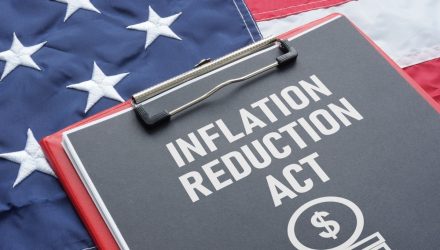The recently enacted Inflation Reduction Act is widely considered a positive, longer-ranging catalyst for renewable assets and exchange traded funds such as the Goldman Sachs Future Planet Equity ETF (GSFP).
Fortunately for investors planning to make a GSFP a long-term tactical holding – perhaps the advisable strategy with this fund – the renewable energy expenditures story spans well beyond the Inflation Reduction Act. Indeed, the U.S. is a major centerpiece in climate-related spending as the world’s largest economy is starting to come in line with comparable developed economies in terms of renewables spending.
“U.S. government spending on climate technology and clean energy will more than triple in the next 10 years under three recently introduced laws, a new report finds,” notes the World Economic Forum (WEF). “The Infrastructure Investment and Jobs Act, CHIPS and Science Act, and the Inflation Reduction Act include more than $500 billion of climate spending.”
Obviously, $500 billion is a massive dollar figure and one that bodes well for funds such as GSFP. It’s also an amount worth putting into context because that exercise underscores the potential potency of GSFP as a long-term idea.
“Over the next 10 years, these new laws will lead to spending of more than $500 billion on climate technology and clean energy, according to a report by clean energy research organization RMI,” adds the WEF. “This will make the next decade of US spending in these areas more than triple what it was in 2009-17, and 15 times higher than in the 1990s and early 2000s, RMI says.”
GSFP fits in this conversation owing to its focus on carbon reduction or decarbonization. That’s important to market participants because that’s one of the broadest green energy concepts and one that will require hundreds of billions if not trillions of dollars to adequately address.
GSFP is up to the task. The Goldman Sachs ETF is actively managed, implying it can react more swiftly to emerging decarbonization spending trends than can passively managed rivals. That gives prospective investors something to think about.
“Investing in climate technologies is part of a big push to tackle climate change by U.S. President Joe Biden’s government,” concludes the WEF. “Other moves include the launch of a Buy Clean Task Force, which is boosting U.S. government purchases of low-carbon building materials to help create a wider market for these items. There are also initiatives to tackle emissions from sectors such as heavy industry, where such reductions are harder to achieve.”
For more news, information, and strategy, visit the Future ETFs Channel.
The opinions and forecasts expressed herein are solely those of Tom Lydon, and may not actually come to pass. Information on this site should not be used or construed as an offer to sell, a solicitation of an offer to buy, or a recommendation for any product.

